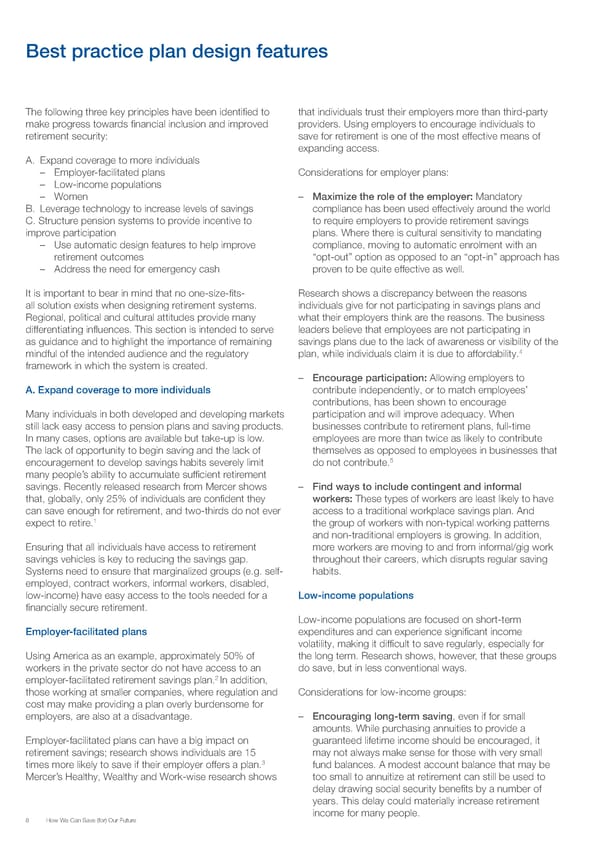Best practice plan design features The following three key principles have been identified to that individuals trust their employers more than third-party make progress towards financial inclusion and improved providers. Using employers to encourage individuals to retirement security: save for retirement is one of the most effective means of expanding access. A. Expand coverage to more individuals – Employer-facilitated plans Considerations for employer plans: – Low-income populations – Women – Maximize the role of the employer: Mandatory B. Leverage technology to increase levels of savings compliance has been used effectively around the world C. Structure pension systems to provide incentive to to require employers to provide retirement savings improve participation plans. Where there is cultural sensitivity to mandating – Use automatic design features to help improve compliance, moving to automatic enrolment with an retirement outcomes “opt-out” option as opposed to an “opt-in” approach has – Address the need for emergency cash proven to be quite effective as well. It is important to bear in mind that no one-size-fits- Research shows a discrepancy between the reasons all solution exists when designing retirement systems. individuals give for not participating in savings plans and Regional, political and cultural attitudes provide many what their employers think are the reasons. The business differentiating influences. This section is intended to serve leaders believe that employees are not participating in as guidance and to highlight the importance of remaining savings plans due to the lack of awareness or visibility of the 4 mindful of the intended audience and the regulatory plan, while individuals claim it is due to affordability. framework in which the system is created. – Encourage participation: Allowing employers to A. Expand coverage to more individuals contribute independently, or to match employees’ contributions, has been shown to encourage Many individuals in both developed and developing markets participation and will improve adequacy. When still lack easy access to pension plans and saving products. businesses contribute to retirement plans, full-time In many cases, options are available but take-up is low. employees are more than twice as likely to contribute The lack of opportunity to begin saving and the lack of themselves as opposed to employees in businesses that encouragement to develop savings habits severely limit do not contribute.5 many people’s ability to accumulate sufficient retirement savings. Recently released research from Mercer shows – Find ways to include contingent and informal that, globally, only 25% of individuals are confident they workers: These types of workers are least likely to have can save enough for retirement, and two-thirds do not ever access to a traditional workplace savings plan. And expect to retire.1 the group of workers with non-typical working patterns and non-traditional employers is growing. In addition, Ensuring that all individuals have access to retirement more workers are moving to and from informal/gig work savings vehicles is key to reducing the savings gap. throughout their careers, which disrupts regular saving Systems need to ensure that marginalized groups (e.g. self- habits. employed, contract workers, informal workers, disabled, low-income) have easy access to the tools needed for a Low-income populations financially secure retirement. Low-income populations are focused on short-term Employer-facilitated plans expenditures and can experience significant income volatility, making it difficult to save regularly, especially for Using America as an example, approximately 50% of the long term. Research shows, however, that these groups workers in the private sector do not have access to an do save, but in less conventional ways. 2 employer-facilitated retirement savings plan. In addition, those working at smaller companies, where regulation and Considerations for low-income groups: cost may make providing a plan overly burdensome for employers, are also at a disadvantage. – Encouraging long-term saving, even if for small amounts. While purchasing annuities to provide a Employer-facilitated plans can have a big impact on guaranteed lifetime income should be encouraged, it retirement savings; research shows individuals are 15 may not always make sense for those with very small times more likely to save if their employer offers a plan.3 fund balances. A modest account balance that may be Mercer’s Healthy, Wealthy and Work-wise research shows too small to annuitize at retirement can still be used to delay drawing social security benefits by a number of years. This delay could materially increase retirement income for many people. 8 How We Can Save (for) Our Future
 How can we save for our future Page 7 Page 9
How can we save for our future Page 7 Page 9